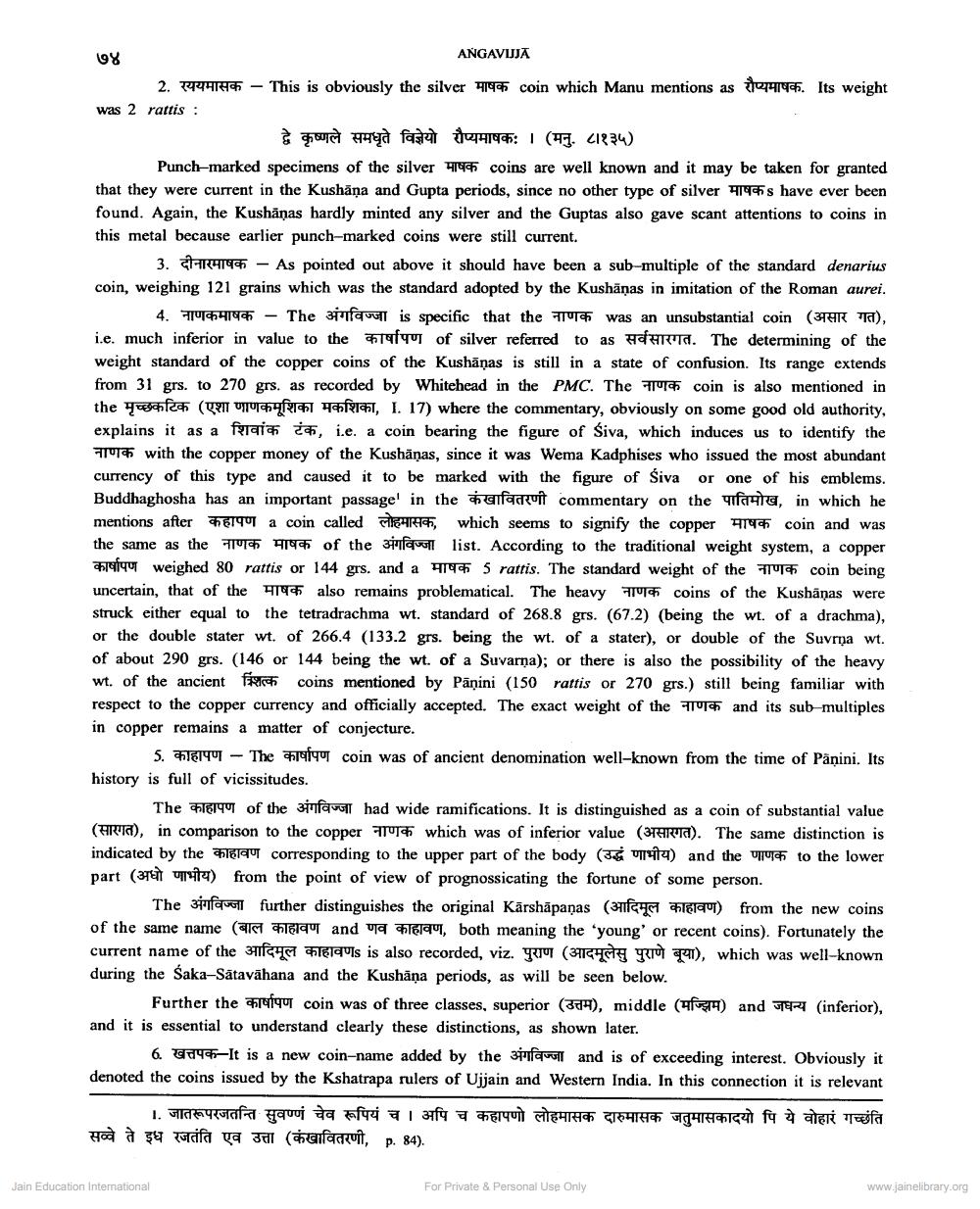________________
७४
ANGAVIJJA 2. स्ययमासक - This is obviously the silver माषक coin which Manu mentions as रौप्यमाषक. Its weight was 2 rattis :
S oud d fast 441: I (99. (1934) Punch-marked specimens of the silver 4994 coins are well known and it may be taken for granted that they were current in the Kushāņa and Gupta periods, since no other type of silver 49s have ever been found. Again, the Kushanas hardly minted any silver and the Guptas also gave scant attentions to coins in this metal because earlier punch-marked coins were still current.
3. 41-641941 - As pointed out above it should have been a sub-multiple of the standard denarius coin, weighing 121 grains which was the standard adopted by the Kushāņas in imitation of the Roman aurei.
4. नाणकमाषक - The अंगविज्जा is specific that the नाणक was an unsubstantial coin (असार गत), i.e. much inferior in value to the lefqu of silver referred to as H ARTA. The determining of the weight standard of the copper coins of the Kushāņas is still in a state of confusion. Its range extends from 31 grs. to 270 grs. as recorded by Whitehead in the PMC. The 71014 coin is also mentioned in the ygfees (R1 07147+421 4 , I. 17) where the commentary, obviously on some good old authority, explains it as a fria *, i.e. a coin bearing the figure of siva, which induces us to identify the 7701 with the copper money of the Kushānas, since it was Wema Kadphises who issued the most abundant currency of this type and caused it to be marked with the figure of Śiva or one of his emblems. Buddhaghosha has an important passage in the alfaut commentary on the fanta, in which he mentions after 61997 a coin called HEART, which seems to signify the copper 194 coin and was
the same as the 1975 1976 of the infawol list. According to the traditional weight system, a copper d u weighed 80 rattis or 144 grs, and a 19h 5 rattis. The standard weight of the Th coin being uncertain, that of the 1975 also remains problematical. The heavy
coins of the Kushäņas were struck either equal to the tetradrachma wt. standard of 268.8 grs. (67.2) (being the wt. of a drachma), or the double stater wt. of 266.4 (133.2 grs. being the wt. of a stater), or double of the Suvrņa wt. of about 290 grs. (146 or 144 being the wt. of a Suvarma); or there is also the possibility of the heavy wt. of the ancient for coins mentioned by Pāṇini (150 rattis or 270 grs.) still being familiar with respect to the copper currency and officially accepted. The exact weight of the 2107 and its sub-multiples in copper remains a matter of conjecture.
5. FETU - The fu coin was of ancient denomination well-known from the time of Panini. Its history is full of vicissitudes.
The 71619 of the infall had wide ramifications. It is distinguished as a coin of substantial value (सारगत), in comparison to the copper नाणक which was of inferior value (असारगत). The same distinction is indicated by the काहावण corresponding to the upper part of the body (उद्धं णाभीय) and the णाणक to the lower part (3 unit) from the point of view of prognossicating the fortune of some person.
The 3ifugl further distinguishes the original Kārshāpaņas (3 4 91610) from the new coins of the same name (ali 169 and ua 1694, both meaning the young' or recent coins). Fortunately the current name of the आदिमूल काहावणs is also recorded, viz. पुराण (आदमूलेसु पुराणे बूया), which was well-known during the Saka-Sätavähana and the Kushāna periods, as will be seen below.
Further the rigut coin was of three classes, superior (3 ), middle (fr) and R (inferior), and it is essential to understand clearly these distinctions, as shown later.
6. UN -It is a new coin-name added by the 3ifquall and is of exceeding interest. Obviously it denoted the coins issued by the Kshatrapa rulers of Ujjain and Western India. In this connection it is relevant
1. जातरूपरजतन्ति सुवण्णं चेव रूपियं च । अपि च कहापणो लोहमासक दारुमासक जतुमासकादयो पि ये वोहारं गच्छंति Ho a Pacifa ya Jul (safavit, p. 84).
Jain Education International
For Private & Personal Use Only
www.jainelibrary.org




